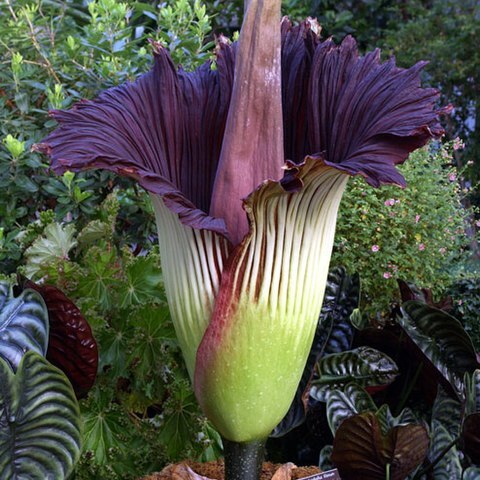Medium-sized to very large acaulescent herbs, seasonally dying back and dormant; stem a usually subglobose tuber. Leaf normally solitary subtended by several basal cataphylls; petiole erect, cylindric, not pulvinate apically, usually smooth, rarely verrucose (A. paeoniifolius), often conspicuously spotted; blade widely spreading, in outline forming a shallow inverted cone, tripartite, each major segment highly divided subpinnately or ± irregularly; ultimate lobes linear to broadly elliptic or ovate, with acuminate tips and broadly decurrent bases; venation of the ultimate lobes penniform, forming inframarginal veins on each side. Inflorescence normally produced before (more rarely with) appearance of leaves; peduncle normally shorter than petiole. Spathe usually with convolute basal portion forming cylindric to bowl-shaped tube, upper portion usually ± expanded, much broader, often with undulate margins. Spadix with basal pistillate portion contiguous with central staminate portion or separated by a short naked interstice, apical portion a variously shaped, sterile, ± smooth (rarely rugose or staminodial), terminal appendix, spongy fibrous within. Flowers unisexual, without perigon. Stamens usually densely congested, in groups of up to 6 (rarely more), sometimes connate basally; anthers usually sessile, more rarely with distinct filaments, dehiscing by apical pores (rarely by transverse slits); connective usually thick. Pistils usually densely congested, sometimes ± distant; ovary 1–4-locular; ovules 1 per locule on basal to axile placentas; style often elongated, sometimes lacking; stigma subglobose or variously lobed, often brightly coloured. Berries borne in ± cylindrical infructescence, 1–several-seeded. Seeds smooth, lacking endosperm.
Small to gigantic, generally deciduous, cormous (rarely rhizomatous), geophytic herbs. Leaf usually solitary, subtended by membranous evanescent cataphylls; petiole erect, sheathing only in lowermost subterranean part, often mottled, sometimes warty, spongy inside; blade rarely pedate, usually highly compound with 3 repeatedly ‘dichotomous’ rachises, with ultimate branches bearing ±pinnately-arranged petiolulate to sessile to partly confluent, mostly elliptic leaflets with brochidodromous venation. Inflorescence solitary, usually produced in absence of leaves, often saproentomophilous and foul-smelling, occasionally sweetly fragrant; peduncle short or like petiole; spathe narrowly ovate and simple to very large and campanulate, variously coloured, deliquescent; spadix mostly sessile, monoecious; female zone contiguous with male (in Australia); pistils naked; male zone ostensibly a mass of stamens or male flowers ±definable, atepalate; anthers sessile, ±truncate; appendix well developed, finger-like to grotesquely gnarled. Infructescence often on elongated peduncle. Fruits ovoid, c. 1–2 (–5) cm long, blue to red.

